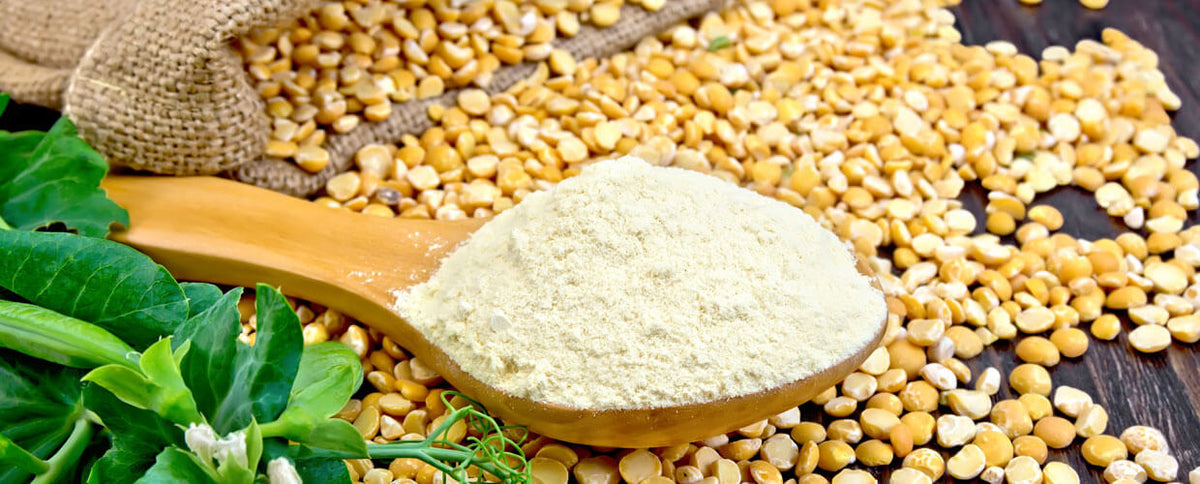6 Things Every Plant-Based Athlete Should Know About Pea Protein

Between soy, legumes, nuts and seeds, seitan, nutritional yeast, and whole grains, there's a variety of different sources of plant-based protein, but one that often slides under the radar is pea protein. It’s a great option if you follow a vegan or plant-based diet, or if you have food sensitivities. “In its isolated state it is suitable for those avoiding common allergens like soy, dairy and wheat,” says Hillary Pride, RDN, LD. Pea protein is also as effective in building muscle as whey protein, multiple studies have found, and it’s high in iron. Here’s everything else you need to know about pea protein to incorporate it into your daily diet via shakes, snacks, and more.
6 Things You Never Knew About Pea Protein
1. It’s a complete source of protein.
It’s rather unusual for plant-based proteins to be a complete source of protein, in that it contains all the amino acids the body needs. Pea protein does, however, which is why you’ll find it in many plant-based protein blends. (Soy protein is another complete source of protein). “Pea protein contains all nine essential amino acids, making it an excellent vegan complete protein choice,” Pride says. “However, because amino acid content varies between all protein sources, it is still important to vary your protein choices to ensure you get adequate amounts of amino acids.” While it does have all of the essential amino acids (which the body can’t produce solo and needs to source from food), it’s lower in the essential amino acid methionine, Pride explains. So it’s important to get a variety of proteins in your diet, especially if you do follow a plant-based or vegan diet.
2. It’s as high in protein content as dairy protein.
In a regular, 30 gram serving of pea protein, there are 27 grams of protein, which is just as much as a dairy-based protein like whey or casein. There are also 120 calories and very little fat and carbs. And, it’ll likely fill you up just as much as these proteins. “It also has as strong of an effect on satiety as casein (a dairy milk protein) does when used as a pre-load meal,” says Carissa Galloway, RDN. Essentially, it keeps you feeling fuller, longer.
Related: 10 Signs You’re Not Getting Enough Protein
3. Pea protein can help build strong muscle.
Good news: Pea protein is as synonymous with building muscle as whey protein, as it contains some of the same essential amino acids as whey, including leucine, isoleucine, and valine, Galloway says.
“Because of its good source of essential amino acids and branch chain amino acids, pea protein will help with muscle recovery,” says Pride. Studies have proven its effectiveness in both muscle recovery and muscle hypertrophy (AKA bulking up). Research published earlier this year also showed that pea protein had similar effects on muscle thickness, muscle mass, and body composition as whey protein when it came to supplementing it along with high-intensity training.
4. There is a significant amount of iron in pea protein.
It can sometimes be tricky to find enough iron in plant foods, but pea protein is a great source of iron, Pride says. Most servings of pea protein include up to 40% of recommended daily iron intake. She points out that Vitamin C increases iron absorption, so it’s best to up your Vitamin C intake as well — think green leafy veggies, broccoli, strawberries, and citrus fruits.
Related: 5 Best High-Protein Snacks Athletes Should Munch Before Bedtime
5. It’s lower in fiber than you may think.
Pea protein can be lower in fiber than other plant-based proteins, like hemp, so it might be slightly less filling. However, this may be a positive if you follow a low fiber or low FODMAP diet. It also may decrease the bloating you might encounter in other plant-based or dairy-based protein products, Galloway adds. But if you need more fiber in your diet, add it to your pea protein shake or smoothie. “Simply adding fiber-rich ingredients like frozen raspberries to a lower-fiber pea protein smoothie can help in boosting satiety,” Pride says.
6. Be wary of the sugar and salt content.
You can find pea protein in various dairy-free milks, vegan cheese, protein powders, protein smoothies, protein bars, veggie burgers, and protein chips at your neighborhood market. But, dietitians say, it’s key to read the labels for the other micronutrients present in these products, along with the sugar and salt content, to make sure you’re not going overboard. In other words, just because it contains peas and is labeled “plant-based” does not make it a nutritious choice.
“The majority of pea protein products are high in sodium, ranging from 100 to 400 grams of sodium,” Galloway explains, “So, people following a low-sodium diet might want to stay away.” You should be safe with an unsweetened protein powder, which won’t contain a ton of salt or sugar.
Pride suggests unsweetened pea protein-based milk — there is a significant amount of protein, about 8 grams per cup. Also, it’s low in carbs. Just remember to study what foods you’re putting in your body, especially when it comes to packaged protein-rich foods that you see at your local grocery store.



